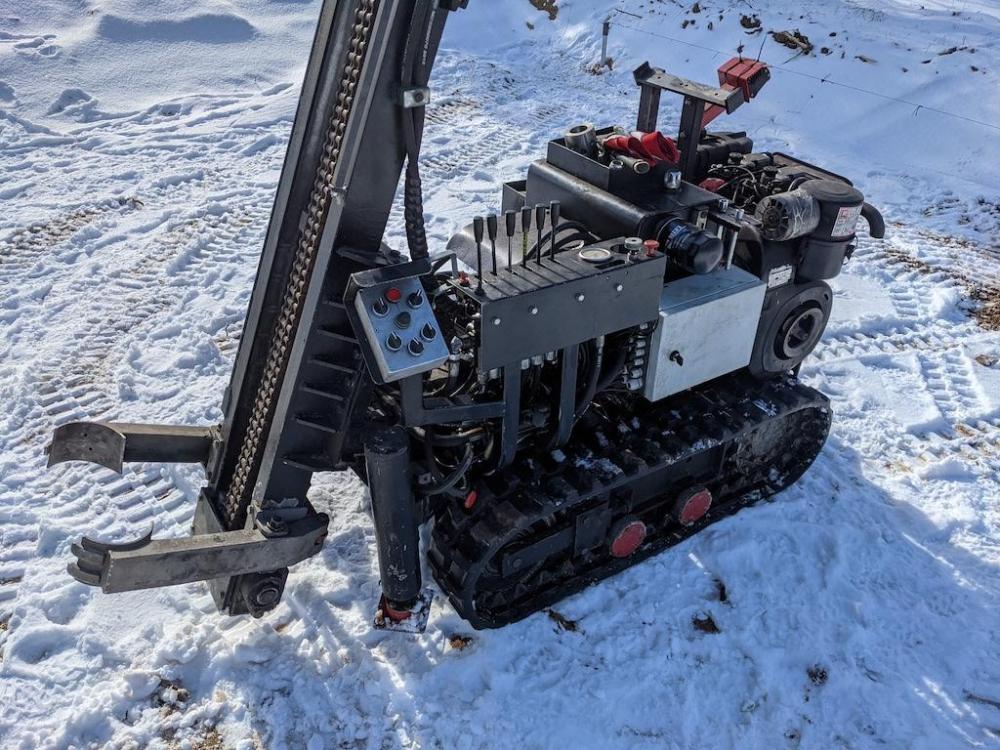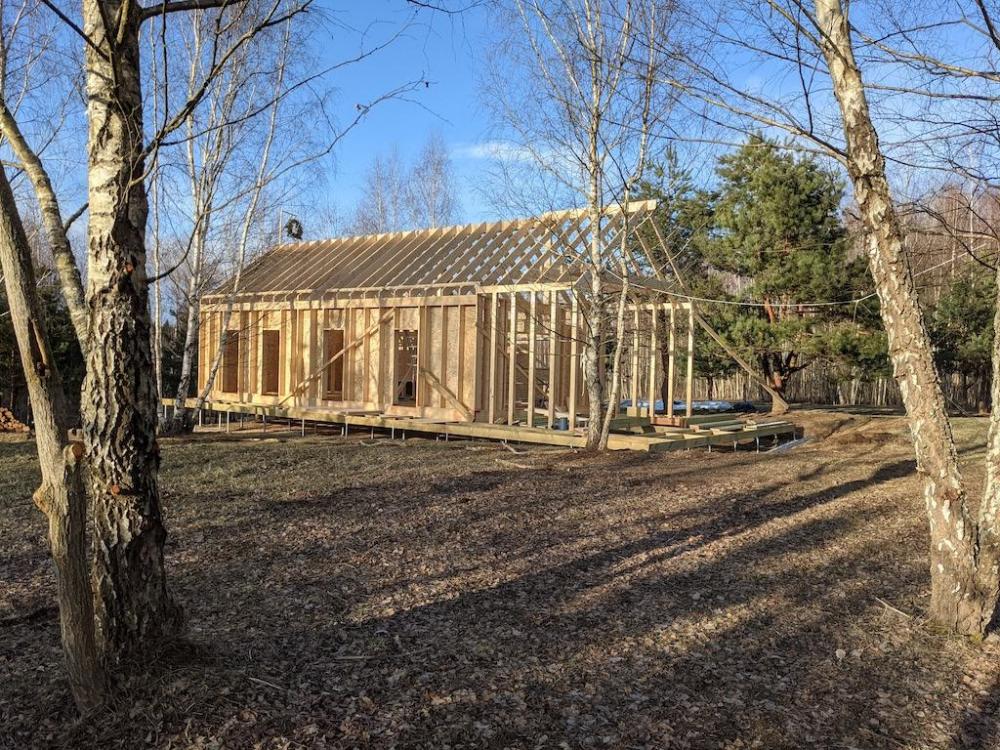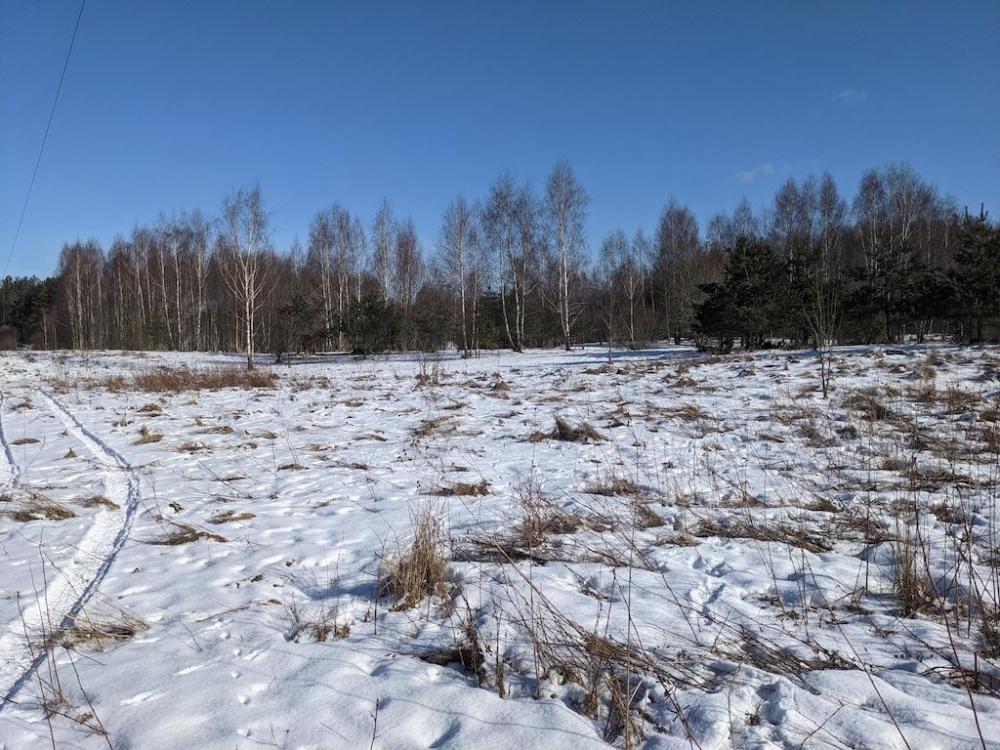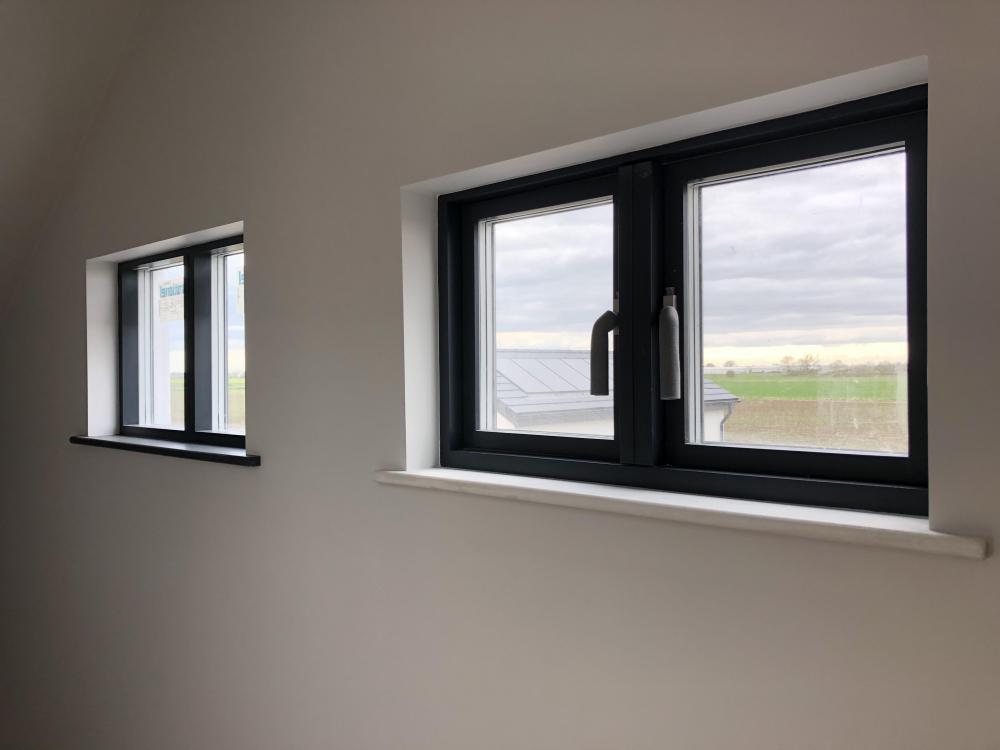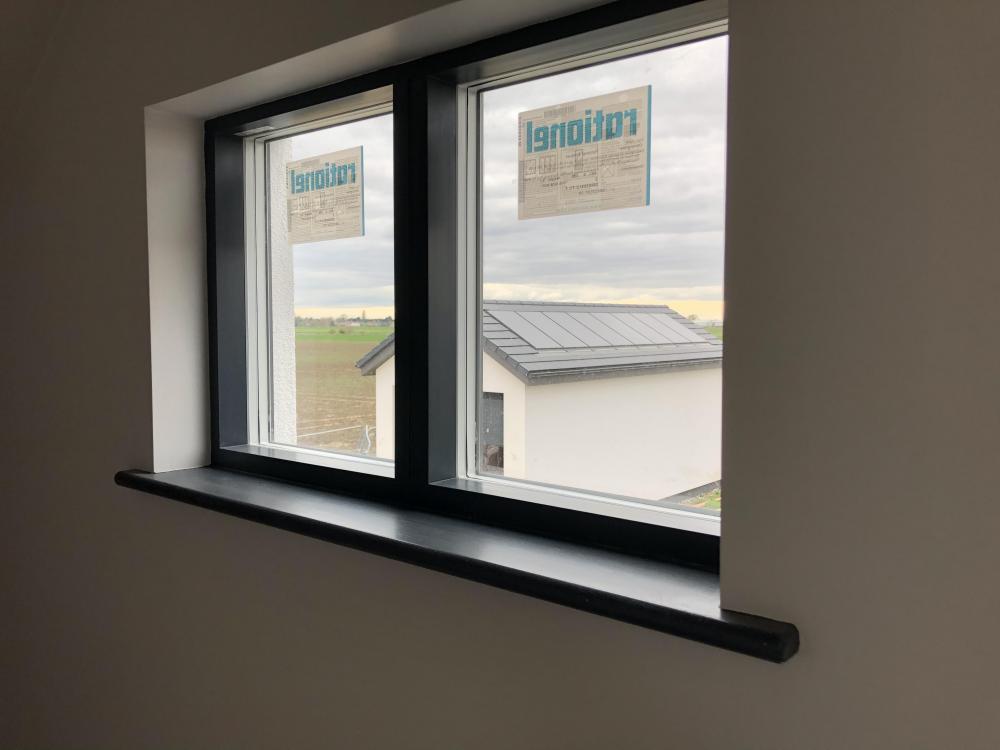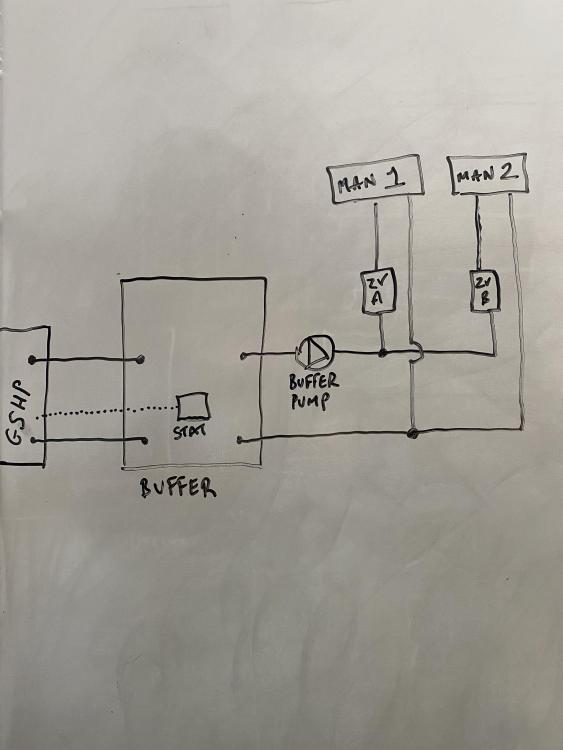Leaderboard
Popular Content
Showing content with the highest reputation on 04/12/21 in all areas
-
Hello, An Englishman with a Lithuanian wife here; building a "practice cabin" on some land she bought at auction whilst there was nothing else to do... There's a saying here (Lithuania) that the first house you build is for your enemy, he second is for sale, and the third is for yourself. As such: House 1: Bought an house that wasn't new. Fixed it up to the point that most of the population would think it great. Annoyed by various bits of it. Longer term We'll build in the back garden then sell the original house. 1970s ex local authority 2 bed terrace in Cambridge. Previous +1 owner was a handy andy carol smiley type. Wiring bodged. Plumbing bodged. Heating bodged. Porch bodged on the front. Attic converted by knocking out all the trusses and calling it good etc. Time (20+ years) says it wasn't going to fall down but flooding or fire were reasonably likely. I think my favourite was the cooker gas supply "sealed" by showing some tile adhesive in the end, bashing the end of the pipe flat and folding it over, then slapping some tiles over it. Stripped back to brick and joists internally; chimney removed down and joists replaced; french windows and larger kitchen window to rear elevation; ground floor open planned; roof jacked back up and steel purlins added; structural partitions on 1st floor to support attic floor. (i.e. sufficiently unbodged not to fall down) Re-wired, re-plumbed, insulated where practical mainly to reduce cold spots/for comfort rather than energy (450 mm loft rolls to the eaves; cut back the brick cavity closures and celotex-ed; 9 mm plasterboard with 25 mm foam to existing concrete window headers; 30 mm EPS between battens on existing ground subfloor w/18 mm chipboard and 14 mm engineered oak on top), MVHR to 1st floor bathroom/bedrooms (for forced ventilation - bedrooms are small, I take in lodgers so doors are shut, the house nowhere near airtight enough for MEV to work, and open windows are a poorly controlled) Biggest wins: MVHR is astounding; if switched on I wake up comfortable; if off I'll wake with did-i-eat-a-hamster throat from mouth-breathing at night due to high CO2 and the windows are moist with condensation. A little mini-split downstairs that bought during a fit of heat induced insomnia/rage is worth every penny for the week or two each year when it's >30C during the day and >25C at night. Works well for heating (the whole house) in the shoulder seasons too. Biggest frustration: mortgage providers won't let you knock down these pieces of rubbish and rebuild them; working around existing rubbish takes far longer, costs more, and achieves a worse result than starting from scratch; tradesmen serving the resi sector are in short supply, with far too many arrogant idiots that need as much supervision as children and come with 10x the back chat. Biggest regret: buying cheap double glazed doors and windows with the structural integrity of wet spaghetti and the airtightness of colander; not digging out the subfloor and throwing in an insulated one with UFH; not planning ahead for a mini-split A/C and running lines to the upstairs landing. (cold air falls / warm air rises so if it's cool bedrooms you're after then you really want that indoor unit on the upstairs landing) House 2: The practice cabin near Moletai (Lithuania). She bought some land at auction and we're building a timber frame "cabin" (12x6m and 1.5 storey/warm roof) as a practice run for building a timber frame house (~6x6m and 1.75 storey/warm roof) in the back garden in Cambridge. SWMBO bought 1 hectare between the highway and some high voltage power lines. It's prettier than it sounds (has trees and the region is just outside a national park) and crucially wasn't zoned as forest or national park. (she's 6' for some context on meadow/weed height!) Planning wise...if <80m2, <8.5m tall, and <6.5m wide, and not a principal residence...and not in the forest or national park...knock yourself out. Building regs...really quite tough if you'd like a resi building. The paperwork is the same for a single house as it is for an apartment building. GPS survey, aerial photo, soil survey, foundation design, structural design, energy modelling, drainage design, electrical design, you name it at €500-1,000 apiece. There isn't really the equivalent of a "deemed to comply" detail and it's the government that set the standards for things not falling on your head rather than the lenders setting the standards for things that won't fall on your head during the mortgage period. For an energy perspective: U-Values: Wall 0.1 Roof 0.08 Windows 0.7 +MVHR +RES (i.e. PV) to offset "most" of the energy consumption of the building https://epbd-ca.eu/ca-outcomes/outcomes-2015-2018/book-2018/countries/lithuania Personally I think this is a step too far. The A+ is ok. (eminently doable and cheap) A++ is getting silly. (probably viable for mid rise apartment buildings with a flat roof full of PV; but frankly you'd be better off spending that money on public renewables that generate in winter when that energy is actually needed) Building regs...if you'd like a non-resi building (a house <80 m2; i.e. a summerhouse / cabin)...are essentially zero though. So we're aiming for: A 12x6 metre "barn" style cabin on screw foundations (I dislike concrete and with no access road / the frost line here being a metre you'd need epic quantities); a variation on Swedish platform framing (sheathed internally with taped OSB as the air tight / vapour retarder layer; rather than solid PE); with posts/ridge beam/warm roof (not that I'd ever add a slightly cheeky mezzanine after it had been certified at 72 m^2 you understand); and insulation with mineral wool (cellulose requires trusting somebody else; fibreglass just falls to the bottom of any cavity and the mice love it; and for foam...you'd best like mice) http://blog.lamidesign.com/p/swedish-platform-framing-info.html https://www.paroc.com/applications/building-insulation/walls/timber-frame-walls Target U-Values: Wall 0.13 (paroc nordic wall = 25 double plasterbaord+50/45 insulated service+12 OSB+200/195 stud+50/45 overlay) Roof 0.1 (same as the wall but 250/245mm rafter and less bridging) Floor 0.1 (22 OSB+250/245 joist full fill+6 OSB+100 underlay) Windows nominal 0.7 (rehau euro 70 3g) Cladding (walls AND roof) to be vertical board on board in black in this style: This is where we're at: Plenty still to do. Joined to ask about air tightness testing techniques (the framers are contracted to get the shell up to the level of wind membrane on the outside, and the OSB on the inside, then it's up to us to do final taping/testing of that inside layer; fit doors/windows; do the external cladding; all the internal fit out) Services wise: Hot water and bathroom UFH / towel rail from a from GSHP (SWMBO thinks solar is ugly; I think air source units are noisy / fugly but mainly I would like to experiment with a GSHP / picked up a Danfoss DHP-H 6 with 1,000 run hours for £650 ). Will install an MVHR unit and bought one but got screwed over by Brookvent (refusing to supply spares for a 4-year old MVHR unit with a failed fan). Need to learn about aerobic sewage treatment plans and drain fields. Need to learn about land drainage. First need to get to a box weather tight enough to breathe and relax some without worrying about how drawings might get mis-interpreted next...2 points
-
@Fraser Lamont I’ve added all the comments to a new thread for you2 points
-
Your patio level is what’s known as ‘level threshold’-there’s no step up into the house as there would have been traditionally. The lower dpc shown should be a continuous barrier all the way around the building, at that level,on both skins of masonry. A level threshold presents a risk that rain splash will affect the wall above dpc level (not having the standard 150mm clearance from ground level) & so an additional dpc is installed,extending a minimum 1m past the raised ground level & lapping down to meet the dpc lower down.2 points
-
2 points
-
Some digging around found my network drive was already mounted //run/user/1000/gfvs with the full path to it being /run/user/1000/gvfs/smb-share:server=192.168.1.254,share=usb1/Ubuntu Laptop/Music/ I have now set that in Site Manager as the default folder to open in Local when I open a connection to the Pi Music box, so I don't have to remember that. So all doing what I wanted and in future I should be able to load new music onto it with a lot less trouble.1 point
-
The main benefit you get from a credit account is the invoicing - I ran a cash account with the merch and it was chaos tbh - switched to a credit a/c and all good.1 point
-
1 point
-
It is often the middle to end of the month following invoice date, so all April invoices payable by xx May etc. The convenience is often not in the credit period offered but in just making a single payment. For contractors they will invoice the client so they get paid before the merchant.1 point
-
HA can open motorised lock easily, but how are you telling HA to open door? NFC or fingerprint or something? I was thinking about using doorbird and a Loxone "NFC code touch" together with a custom front panel of some sort in order to do access/doorbell/video in a single unit. But keen to look at alternatives, which is why reason I came across the UniFi Access Reader Pro.1 point
-
Plenty of single track lanes about. If visibility is OK should not be an issue. You don't want to be getting a little way along then having to reverse.1 point
-
Heras will be fine with Ledgers and bracing to stop it falling over or sliding into the trench1 point
-
1 point
-
Yes, some timber frame houses have had problems, but look at all the standing Tudor and even older timber frame buildings. Whats on the outside? does it look intact? is the roof ok? most brick houses still have a lot of structural timber in them so dont be afraid, just cautious as with any older building1 point
-
1 point
-
Most single track roads widen to 2 track at a junction so a car waiting to exit the single track road does not block another car trying to enter the single track road. You would appear to be achieving something similar so it looks like a positive move if you can achieve it.1 point
-
If this is a cantileverd structure then the bolts would be redundant surely - nails would be sufficient. The OP needs to better describe the stucture.1 point
-
28” monitor ..! But you can see the bolt head in one of the photos plus it was confirmed.1 point
-
Welcome ..!! So the industry is busy at the moment so “silly quotes” may be that trades don’t want the work, or you’re in a very expensive part of the country. What sort of size studio are we talking ..?? Do you have plans ..??1 point
-
1 point
-
Agree with Nod. and as the cracks are not straight you may find the paint will just peel off to reveal little and possibly no cracking underneath. (Thick vinyl paint straight onto bare plaster so not keyed in etc will often shrink and crack but peels off really easily ... so theraputic)1 point
-
1 point
-
I could be wrong, but I think that info came from a single poster (I believe I remember who, but won't say in case I'm wrong). I actually think it's more usual for the GSHP unit (the heat pump itself) to be placed outside the house. Since it doesn't need a high volume airflow like an ASHP, there's also nothing to stop it being enclosed in a relatively sound-insulated enclosure. I think the main issue for the low interest in GSHPs is relative cost. It costs to dig, then you need to buy loads of pipework, then you need to buy the anti-freeze that fills the pipes. The anti-freeze then needs to be replaced every few years, from memory, which adds more cost, along with the hassle of safe disposal of the old fluids. For all this cost an effort you get a slight improvement in COP relative to an ASHP. The additional costs of GSHP mean you'll probably never make up the higher installation and maintenance costs.1 point
-
Hello everyone, Came across this forum by chance when reviewing information about cesspits as my new home has one and doesn't look to be in good repair. At least you'll be able to smell me coming. Enjoy and stay safe.1 point
-
The automation guy wanted me to put in extra sensors that could be programmed to put the lights on at a lower brightness level at night, but as I already had sensors going in it was too late and a lot of hassle to change.1 point
-
Nope - persuade wealthy people to invest their money in a company which is extremely unlikely ever to make any money. They'll lose their investment, but the (less wealthy) people running the company will get a good living out of it for a few years.1 point
-
Oh bleedin' 'ell... I thought it was just me... it makes me so cross. My folks would not (affect not to) notice if all the lights - inside, outside in my lady's chamber, garage, hen house, piggery all came on at dawn and weren't switched off at about midnight1 point
-
I have all these rooms on sensors. I noticed in our last house that whenever we had visitors they never turned off the en suite lights. These were also connected to an extractor fan so that would be left running for hours as well. I don't know why it is not standard to have bathroom, utility room lights etc on a sensor. Not only does it save electricity but you don't need to install switches and root around for lights in the dark.1 point
-
I have set the automation to switch off all of the lights at 8.10am and then again at 10pm so that it switches off all the lights (or at least the ones that are automated) during the school run in the morning and after everyone has gone to bed. My daughter absolutely insists that she needs all the lights on in the kitchen whenever she is in there, no matter how bright it is outside. I also find TVs on in empty rooms all the time. Clearly things have changed since my mum was younger.1 point
-
Just shows; tek yer eye of t' ball in this place for a minnit, and yer toast.... toast.?1 point
-
It's gibberish. --------------------- The fuel involved is usually natural gas. This is burned in a central boiler in order to heat water that flows to radiators elsewhere in the building. Britain's government would like to change this. From 2025 gas-fired boilers will be banned in newly built homes. By the mid-2030s installing new gas boilers in existing houses will be banned, too. The question is what will replace them. Unlike electricity generation, where renewables are proving popular, or cars, where battery-powered vehicles are rapidly becoming established, the market for green heating is anyone's to play for. The usual suspects (assuming any electricity supplied is generated using appropriately carbon-free means) include electric immersion heaters, heat pumps (devices that work a bit like refrigerators in reverse, in that they extract heat from a building’s surroundings and then pump it into that building), and burning hydrogen instead of natural gas. Engineers at a small British company called Heat Wayv, though, think they have another contender: microwaves. The principle is the same as in a microwave oven. Many molecules, water included, are electrically dipolar. This means they have a positive charge at one end and a negative one at the other. They will therefore rotate to align themselves with a strong electromagnetic field. If that field is oscillating, as is the case with electromagnetic radiation such as microwaves, then the molecules themselves will oscillate too—bumping and jostling their neighbours as they do so, and thus creating heat. But there is more to building a microwave boiler than simply repurposing the parts used for an oven, says Phil Stevens, one of Heat Wayv's founders. Most microwave ovens employ magnetrons—chunky devices built by surrounding a cathode with a carefully shaped anode that is designed to produce electromagnetic radiation of a specific frequency. With the help of a pair of big chipmakers, Heat Wayv has come up with a solid-state device that performs the same job, but which fits on a 10-square-centimetre silicon chip. Arrays of these devices beam microwaves into water in a boiler, heating it up. The pipes that carry the water are also made of microwave-sensitive materials, as is the insulation that lags them. And a heat exchanger recycles residual waste warmth. The upshot, says Mr Stevens, is a boiler that is about 96% efficient. The best existing gas boilers rarely exceed 90%. Efficiency matters, because the move away from gas may mean higher heating bills. Electricity generated from fossil fuels is necessarily more expensive than the fuels themselves. In Britain, at the moment, a given amount of energy delivered as electricity costs three or four times as much as the same amount delivered by natural gas. Switching to renewables is unlikely to change that much. Though the “fuel” involved (wind or sunlight) is free, other costs are often higher than for conventional power stations. Forced by law to switch from gas, then, customers will surely have their eyes on the cost. Heat Wayv argues its technology offers advantages over rival methods. Immersion heaters must run continuously to deliver water at a suitable temperature. That often warms water which is never used. By contrast, and like existing gas boilers, microwaves heat water quickly enough to provide it only when it is needed. Heat pumps, too, have drawbacks. Their efficiency plummets on cold days, when they are needed most. They are also bulky. And they generate water that is warm rather than hot, often requiring the retrofitting of bigger radiators or underfloor heating. Hydrogen, meanwhile, must either be extracted from natural gas or created by running electrical currents through water. Both processes are inherently inefficient and the former is hardly green. Also, the infrastructure needed to produce and deliver hydrogen in quantity does not yet (and may never) exist. Heat Wayv hopes to be producing microwave boilers for sale by 2024, in time for the first stage of the government’s ban. Mr Stevens says the idea has attracted interest from most of Britain’s big housebuilders. Soon, perhaps, microwaves may heat people’s water as well as their food.1 point
-
I came home on Christmas Eve a few years ago to find that every single light in the house was on. I mean that literally - every bathroom, toilet, hallway, bedroom etc light was blazing, with just my wife and two children at home (all of them downstairs in the kitchen). A recent tweak to my home automation programming lets me open my phone, click a single button on the app, and turn off every single light in the house except the living room where we watch TV. It gives me great pleasure.1 point
-
I have the Amcrest doorbell https://www.amazon.co.uk/Amcrest-SmartHome-Doorbell-Weatherproof-Wide-Angle/dp/B0844YVN5M It's wifi rather than PoE, alas, but otherwise a pretty reliable option. I have it wired via a 25ohm resistor dummy load to a digital input on loxone, which triggers the old 60s door chime (literally the only visible part of our house we retained) It has an optional cloud recording service that is tolerably usable, 1 year free trial is useful while I get the real setup a bit more polished. I'm streaming from it to BlueIris, which transcodes and can provide composite views for Home assistant or Loxone app or pop up on the living room TV or whatever1 point
-
It can cause old joints to give up, but only in extreme situations really. The pipe is physically moving during generation of the hammer noise so it is something to address if possible. The UVC is a cold mains dependant device so hot and cold are married, hence the issue sometimes resides on both supplies, but giving the system some expansion at source ( stopcock ) should wipe the issue out systemwide.1 point
-
It was one of the two million decisions that needed to be made! Someone nearly put me off by mentioning seeing dust all the time, then I remembered we used to have black window boards with black frames and they didn’t show the dust any more than white ones did. Very happy with our decision ☺️1 point
-
He came to see the footings Said it was a bit muddy send photo He came to see the roof Didn’t climb up Said it looked a grand job Final inspection Said he was covering for a sick colleague could stop Gas cert slate cert electric Copy of BC cert Didnt go upstairs or walk round the outside They know they will never have to pay out But we will need the cert when we sell next year1 point
-
If you currently use Worcester 30Si then it will surely cope with heat demand, even more so when you improve insulation Your problem may be the UFH itself - the limit of floor surface temperature and thus heating water temperature as well as choice of surface may limit the heating power radiated by the floor.1 point
-
1 point
-
Firstly, as this is my first post since joining the forum a few years ago, a big thank you for all the invaluable info your debates have provided. I ended up here again while doing research to confirm my MVHR design. Most of what I want to say has been said in this thread already - I just want to say it my way! After years of struggling with planning authorities I am finally half way through an extensive bungalow extension/refurb for my parents, not the original plan for my whole family but that's life, compromise had to be made, we keep their draughty old house! The plan is also to divide off a previously built side extension to provide a separate rentable property to help pay back the mortgage quickly. As for the current topic; a term I have not seen mentioned so far, and one which provides the best argument against the thread title, is cost/benefit ratio. Many purchases are unjustified on pure cost alone (House/Car/TV/Weddings/Holidays/Eating out/Drinking/Pets/Kids! etc) but the ultimate goal in life surely must be to live happy and content. In a world that increasingly seems to be run by accountantcy principles, I think the value of the latter is often sadly overlooked. As these will be kept as my own properties but not occupied by me, I will concentrate on the cost/benefit to me regarding my investment. On one hand, I can justify an MVHR system in the house my parents will occupy as it will contribute to keeping the house fresh (I can relate to all of joe90's comments about his parents - and to add: my mother's cooking odours make the whole house unbearable and she often forgets to turn the hood on!). Without this, chances are I will be spending more on a refresh when I eventually get my house back. Also, there is a small possibility I may want to move here after my parents so the personal comfort benefit is coming into play to justify this investment. In the second rentable property, I have opted to splash out on UFH as I believe the general public is now beginning to recognise this as a 'love to have' comfort feature and the benefit to me is a more desirable property. The MVHR would be wasted on this property as I can see no benefit to outweigh the installation/maintenance cost. I don't think the general public are aware of the comfort benefits yet so I don't believe it will affect the value of the property. To sum up, MVHR certainly has undeniable benefits but the ROI is debatable, so if on a tight budget and you worry about your life's pot of cash running out before your end then there are cheaper options to keep you happy. On pure cost/ROI, the OP has made a very good argument, but the title of the thread is very misleading and aggravating to those who are realising it's benefits, it is not a bogus technology which should be dismissed. It's like saying buying Mercedes cars for lifetime cost is bogus because several budget cars will do the same job cheaper, I'm sure there are strong arguments both ways for efficient ROI, but bottom line is: if you can afford it then the feelgood factor from the extra comfort is undeniable. I know a few individuals who, despite having a generous income, constantly debate ROI without giving equal importance to quality of life/environment, all come across as boring miserable people. Whoops! I have a habit of writing too much then editing bits out to make it less of a novel to read. Just realised I need to get ready for work very quickly so posting as is before I lose it all. Sorry1 point
-
like @Cpd said I would caution putting PIR in a stud wall. it’s a tricky slow job to get right ( which means it almost never is). Add to that the shrinking of timber and board insulation and you’ll have a wall full of gaps and a cold house. Save your builder some heartache and your pocket some cash and use a good quality insulation batt. Doing much to boost U values beyond building regs isn’t near as useful as getting really good airtighness, MVHR and triple glazing. Worrying about the third decimal place in U values (although it is a pastime of mine!) won’t get you a warm house. Good detailing will.1 point
-
During this hopefully short cold snap I decided to do a little experiment to see how our existing gas boiler system works assuming it is set at 45c, to mimic a heat pump system. My main concern is obviously whether or not the microbore supplied downstairs radiators would work ok and heat the home. through today the outside temperature has been around 7 to 9 degrees. Our home is set at 19 degrees through the day. To date we have only run the gas boiler for an hour morning and four hours evening, again at 19c. For the experiment to mock up how the heat pump would be working through the day it has been running 0630 to 2100 hours. I have also purchased a temperature digital thermometer from Toolstation of the probe type (£10). This appears to be accurate against other thermometers I have in the home. I have managed to set the gas boiler to c45 degrees (quite a modern Worcester system boiler). First task was to see how the flow and return temperatures faired on the 22mm pipes direct from the rear of the boiler, for both the UVC recharge and rad heating cycles. interestingly the heating flow is 45.9c and return 40.0c, which is very close to that delta t which a heat pump would operate (5c I understand) and less than the 10c I understand most gas boilers work to. The UVC cycle was bout half a degree greater so that delta t is about 6.5c. the radiators in the ground floor which are fed by microbore seem to fair well. The single panel lock shielded rad in the hall was running at 44.5c so not much heat being lost en route to that one. The large two double rads in the living room at the opposite end of the house to the boiler were running at 42c or thereabouts, but these are the largest rads in the home. The living rads are well oversized though. so far the house has been very comfortable and the boiler has mostly been off. Taking off the hot water gas use I predict all day we have used 40kwh of gas, quite a chunk of which was in the morning getting the home from 16.5 to 19c (I would say 15-20kwh on that task alone). The real test will come on Monday and Tuesday when the temperature is going to drop to around 4-5 day but poss below zero evening. I would appreciate thoughts on our measured delta t of less than six degrees, as to my kind it would appear our system retrofit could hack running at 45c without problem high delta t. Ok the pump is set on it’s highest setting but noise from the boiler itself is the only thing we can hear. I am hoping our microbore is not going to be an issue, but if I am missing something please let me know. obviously the Monday and Tuesday temperature tests will confirm if 45c will heat the house so an update will be forthcoming!1 point
-
Just remember that PIR between studs had to be done very well (foamed AND Taped) if it’s done shite then it’s as much use as an ashtray on a motorbike.... Doing it really well is very time consuming (I am doing it right now....) and you should not “assume” your builder is going to do a pukka job if working to a set price or finds this sort of detailing “unnecessary” using a compressible insulation between the studs gives you a much better chance of getting it right and then stick as much PIR as you can (within reason...)on the inside to really bolster up your U-Values.1 point
-
You are going to a lot of trouble to enhance the sound on The One Show. SWMBO should install some software to ban you from the AV forums.1 point
-
U value 0.14 overall thickness 360mm Inside to out: plaster skim 12.5mm plasterboard 25mm battened service void Air tight membrane 2 layers 12mm OSB (racking layer) 195mm timber frame filled with Frametherm 35 insulation 100mm Pavatex wood fibre board Baumit thin coat render system.1 point
This leaderboard is set to London/GMT+01:00

.jpg.c21f3ac78c9b7efd90cbdcb312744dc5.thumb.jpg.7adcad4c0e384f5ecd7d56b0618df6e5.jpg)



